ProModeler (Hasegawa) 1/32 Bf-109G-4 – Regia Aeronautica
The ProModeler release of the Hasegawa kit, done some 14 years ago (unfortunately the model didn't survive the last move, but the photos are still nice).
The Gustav Series:
The appearance of the Gustav series of Messerschmitt's Bf-109 was due to the ineptness of the Luftwaffe high command in developing an acceptable production successor to the aging Bf-109 design, and reflected the lack of long-range planning on the part of the Third Reich for the war Hitler wanted. The highly-promising Fw-190 was just beginning its career, but it would never be able to match the high altitude performance of Messerschmitt's product, which became more and more important as the war wore on and air combat occurred at ever-greater altitudes with the introduction of American daylight bombing. The Gustav series, which was produced in greater numbers than all the other versions combined, was actually the least of them all, since the design peak of the Bf-109 was the Friedrich series; the Gustav represented more and more weight added for less and less return. When first introduced into the Jadgwaffe in 1942, the Bf-109G was considered a retrograde step in development by the pilots. Heinz Knoke described the flying characteristics of the Gustav as “atrocious,” with the airplane having to be flown at full power in the landing circuit just to maintain altitude and maneuverability once the gear came down.
All the previous versions of the Bf-109 had mitigated the demand for maximum possible speed with recognition of the importance of maneuverability and handling. The higher power and weight loadings represented by the Gustav series was considered acceptable in order to achieve the increased emphasis on speed, despite the reduction in maneuverability and handling capabilities.
The DB605A engine that powered the Gustav series differed from the DB601E used for the Friedrich in having a redesigned cylinder block in which the maximum possible bore was obtained while retaining the original cylinder centers. Cylinder compression ratio was increased to 7.3 for the left cylinder block and 7.5 for the right. Maximum r.p.m. was increased to 2,800. The result was an engine with virtually unchanged overall dimensions, with take-off power increased to 1,475 h.p., with 1,355 h.p. available at 6,000 meters. GM 1, a system for injecting nitrous oxide into the engine at high altitude, had an enormous effect on performance, increasing output to 1,250 h.p. at 10,000 meters.
The Bf-109G also had a pressurized cockpit initially. This was a “cold wall” type in which the engine wall, cockpit floor and the sloping plate behind the pilot's seat were all sealed, and designed to provide a pressure differential of 4.4 lb./sq.ft. The system was only used in the Bf-109G-1, G-3 and G-5; the others of the series lacked pressurization.
The first Bf-109G to enter service in numbers was the Bf-109G-2, which first saw combat over the Channel Front in the spring of 1942. The additional weight of the Gustav required that the landing gear be beefed up; the G-4 version was the first to have “bumps” on the upper wing surface to fair the increased size of the wheel well for the larger-size main wheels, while a non-retractable tailwheel of increased size was also adopted. These early Gustavs retained the engine-mounted 20mm MG 151 with two 7.92mm MG 17 machine guns in the forward fuselage, as developed for the Friedrich series. This armament could be supplemented by Rustsatze-6, which involved fitting an additional two MG 151s in underwing gondolas just outboard of the wheel well; while this provided a useful increase in weight of fire for anti-bomber operations, the additional weight of the canons had a deleterious effect on maneuverability of what the Germans called the Kannonenboot (gunboat).
With the Bf-109G being mass-produced, the Gustav was the first of the 109s to widely equip other Axis air forces, whose domestic aircraft industries were either non-existent or unable to produce modern fighters in sufficient numbers for their air forces to meet the Allies in combat on an equal footing. The first of these allied air forces to obtain the Bf-109G was that of Finland, commencing in January 1943. The Finns were followed shortly by the Hungarians and the Romanians during the spring of 1943.
Following the defeat of Axis forces in North Africa in early 1943, the Regia Aeronautica was forced to admit that while the Italian aircraft industry could produce first-class fighters such as the Macchi C.202 and Reggianne 2001, the industry could not possibly produce these aircraft in sufficient numbers to maintain attrition, let alone embark on expansion. Thus, the Italians too were forced to turn to Germany for more modern fighters. In May 1943, 3rd Grupo exchanged its surviving C.202 Folgore fighters for Bf-109G-4s, most of which were the Bf-109G-4/R6 version with the two underwing 20mm cannon. During the next two months of operations, losses would be replaced with Bf-109G-6/R6 aircraft. When the Allies began the Pantellaria campaign in mid-May, at least one Squadriglia was able to enter combat in the bomber-interception role, though losses against Allied fighters were heavy. Following the surrender of the garrison on Pantellaria, the Sicily campaign began in earnest. 3rd Grupo was joined by the similarly-equipped 150th Grupo, composed of the 364th a and 365th Squadriglia, in early June. Allied bombers were well-escorted by fighters from Tunisia and Malta, and major dogfights erupted over Sicily daily.
Conditions in Sicily were chaotic on the Axis side. Most prominent was the failure to establish a centralized fighter control; German and Italian units continued to operate as if the other was not present. On July 3, 1943, the Bf-109Gs of 150th Grupo intercepted Baltimore and Boston bombers of the Desert Air Force, escorted by P-40s from a “green” American unit. Three bombers and seven fighters were claimed shot down, for the loss of one Bf-109. 150th Grupo gained further successes before the invasion, becoming the most successful unit of the Regia Aeronautica to use the Bf-109G. This was all for naught, because the Allied invasion on July 10 saw both Gruppi of 109s virtually wiped out on the ground due to Allied air attacks on their bases. Surviving pilots of the units managed to evacuate to the mainland, where many would eventually fly the Bf-109G again, as members of the ANR.
For me, the big difference between this kit and the other 1/32 Bf-109s in my collection was that I did not use a resin cockpit. This wasn't because I didn't have one ready, but because I decided to see just what one would get with a closer out-of-the-box project. The one concession to the aftermarket was the use of Cutting Edge posable resin seat belts; to me, if you do nothing more than dress up the seat of a moderately-detailed cockpit, you can improve the look a hundred percent. Interestingly, once completed and compared with another model, the Awful Truth emerged: from a foot away, it's just about impossible to tell the difference between the two cockpits! Yes, go in close and the differences become obvious, but if your main interest in building the kit is for markings and paint scheme, you really can get away with saving $20 on a resin cockpit - money you can put toward buying another kit!
As far as construction of the rest of the kit is concerned, what can I say? Hasegawa has taken the “shake and bake” production design philosophy to its ultimate expression with these Bf-109 kits and their fellow Fw-190s. If you follow the instructions, it is just about impossible to screw up the construction of the model. Everything fits closely enough that I only used some Mr. Surfacer on the centerline seams in the nose area and along the leading edges of the wings.
The Regia Aeronautica Bf-109s were simply Luftwaffe aircraft that came in standard markings, which were overpainted and Italian markings provided. Thus, I did an “Augsburg scheme” camouflage pattern, RLM74 AND rlm75 upper colors, RLM76 lower colors, and a fuselage mottle of RLM02, RLM71 and RLM74. This was applied after pre-shading the model with flat black along the panel lines, and I used Gunze-Sangyo “German Field Grey” for the RLM74, Gunze “Medium Sea Grey” for the RLM75, Gunze RLM76, and RLM71 with Tamiya RLM02 for the mottle. After this was dry, I used a mixture approximating Italian “Azure Grey” to overpaint the areas of the German national markings. Mediterranean Theater ID markings of white spinner, white fuselage stripe and white wing tips was done with Tamiya Flat White and masked off before applying the camouflage pattern. When all was dry, I gave the model a coat of Future.
I used the decals from Aeromaster 32-038, which has markings for two Regia Aeronautica Bf-109G-6s of 150th Grupo - I did a cut-and-paste with the side numbers to create a Bf-109G-4/R6 that is shown in profile on a Third Group Decals sheet of Regia Aeronautica and Aviazione Della R.S.I. Bf-109s.
Another 109 in one of the many markings possibilities for this airplane that served with every Axis air force on all fronts. These Hasegawa kits have made me a believer in Big Models for certain projects.
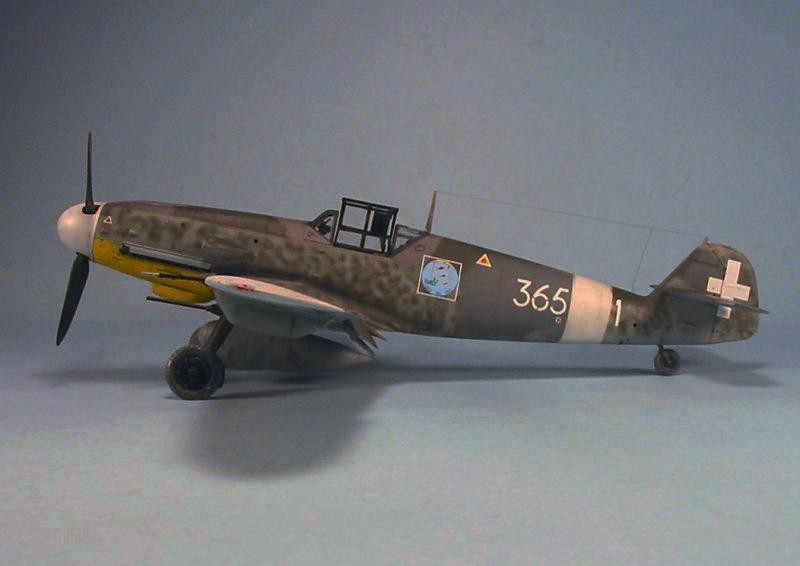
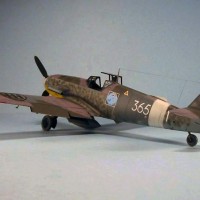
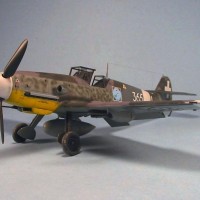
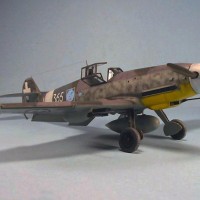
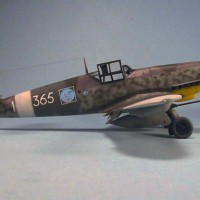
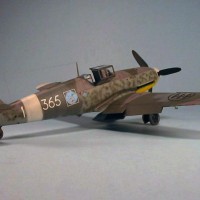
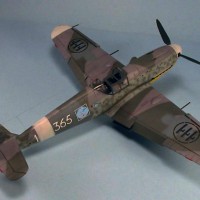
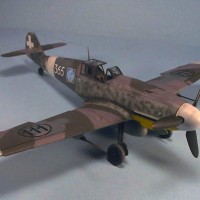
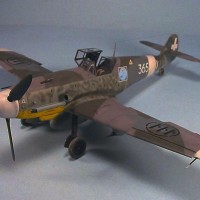
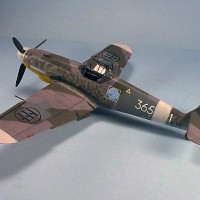
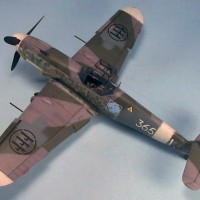
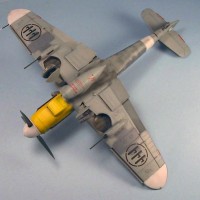
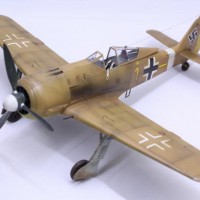
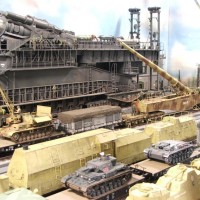
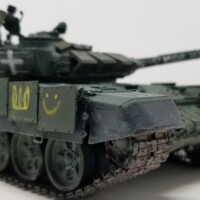
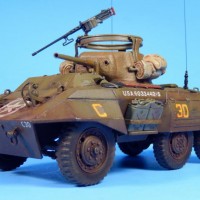
I knew this was another TC build as soon as I saw the headline photo - nice work.
Thanks! I'm that obvious, huh?
Not "obvious"...more like "unique" (and your photos are more or less a "give away" now). Good eye...(or is it "eyes") -
Thank you, my bureaucrat-run, government-financed single-payer health system, aka the Veteran's Administration, for which I only had to serve a year in hell to qualify, which (for free!) operated on my eyes and restored them to what they were 35 years ago (not quite the "ace's vision" 20/10 of my youth, but close enough to 20/20 that the State of California no longer requires I wear corrective lenses while driving is good enough) - I can even build 1/72 kits again!
Great looking finishes.
Paraphrasing "Animal Farm": "All compliments are equal, but some are more equal than others." Particularly when one is aware of how much knowledge a particular complimenter has.
I do miss that model. Having just discovered another Pro-Modeler G-4 kit (half price compared to E(vil)Bay, couldn't resist) I may need to go look for that decal sheet again and re-do it.
This is a fine Gustav, Tom. I wish you well with your new "replacement."
Like Craig, I can spot one of your contributions right off. Your history "lessons" are very interesting and very welcome.
My experience with the VA is simple: they saved my life in '09 when they found Stage 4 kidney cancer ... then removed it - along with half of my R kidney. I'm happy to hear of your "good eyes" experience.
Interesting history and a nice looking model as well Tom. And yes your headline pics are a dead giveaway for what's to follow. I've observed that many iModelers seem to have their own little unique signature posts.
It is a big call but that's some of your best painting Tom, fantastic!
Thanks Paul. You never know til it's done.
Gorgeous. Absolutely beautiful bird with great pics and narrative.
I really love that one! The change-over to Italian livery is really sweet - I may have to do one like that and use yours as a reference. So sorry to hear it didn't survive...
Love it, oddball all the way. Interested in your choice of RLM74 & 75. I just received 2 bottles of Gunze Mr. Hobby Aqueous Hobby Color. H68 is RLM74 and H69 is RLM75. Living in an isolated community mean my choices for paint are nil so I rely on others for their paint interpretations.
I never agreed with some of Gunze's Luftwaffe colors, back when we could get them in the States. RLM 74 is "Graugrun" - "grey-green." RLM 75 is "Grauviolett" - "grey-violet." Gunze doesn't come close with either one, but if you mix a bit of Japanese Navy Green (like 1 part green to 5 parts the "RLM74" color Gunze has) it comes close. Mix some Gunze violet (same mixture 1:5) with the "RLM 75" and you're close. Their RLM76 is pretty much dead on.
Thank you Tom. Added your mixes and your paint choices to my ever expanding list. I've found an online site in Japan with Gunze paint that has very reasonable shipping prices if I can get the Canadian dollar back up to $0.80 U.S.
You’re lucky you can get Gunze. I love that paint. They didn’t want to go through revising the labels to fit the US market, and now you can’t get any.